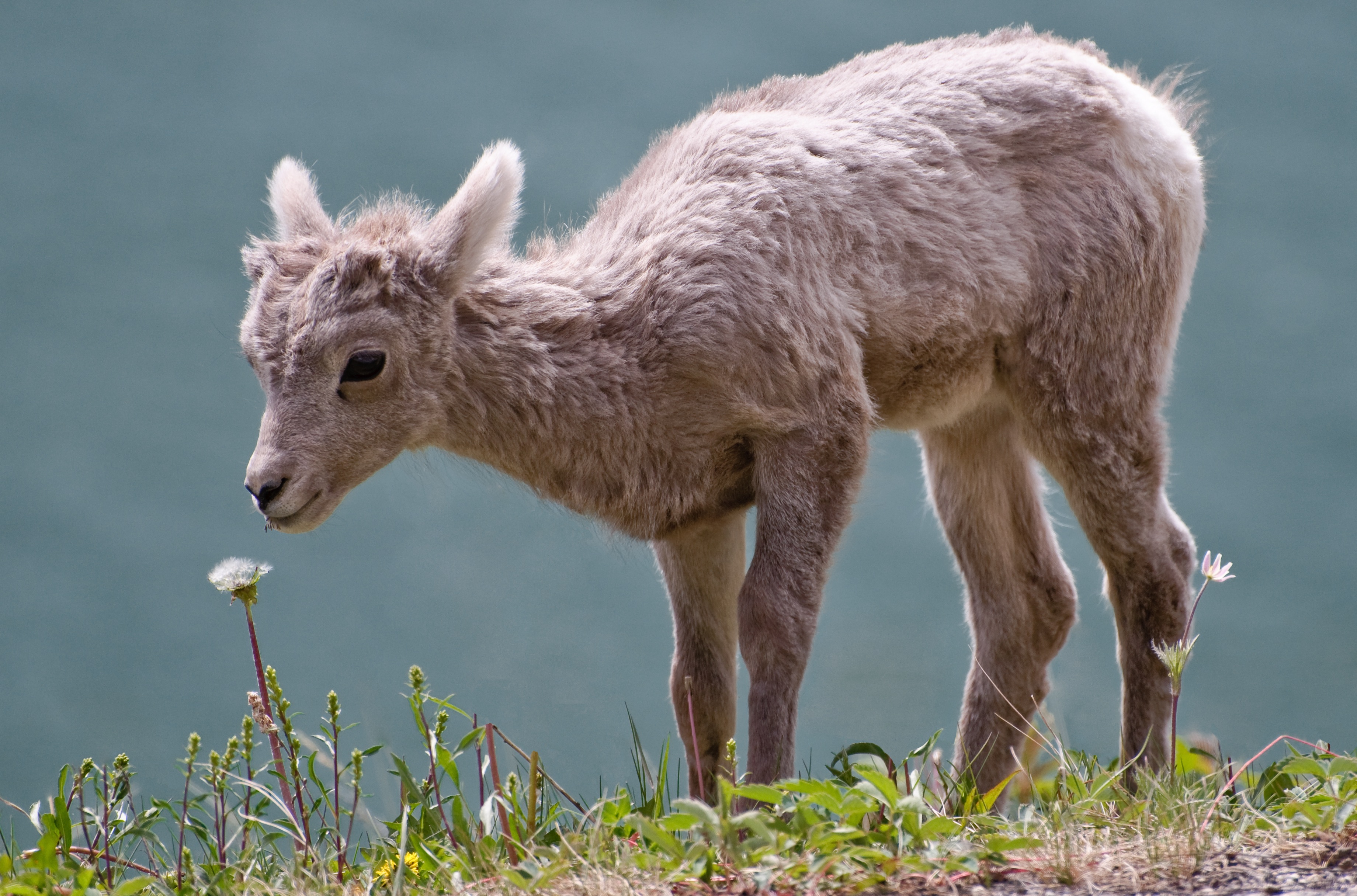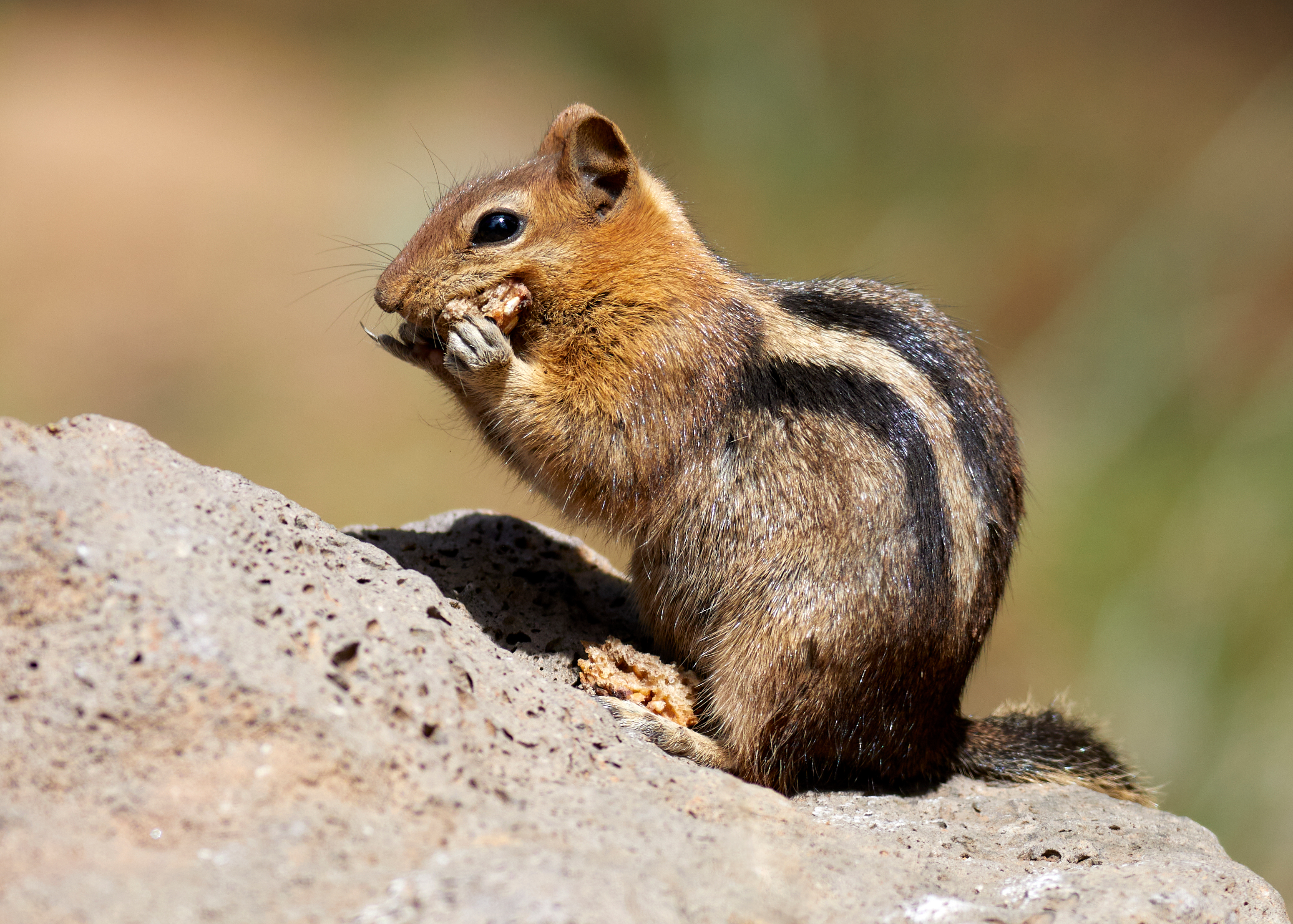|
Golden-mantled Ground Squirrel
The golden-mantled ground squirrel (''Callospermophilus lateralis'') is a ground squirrel native to western North America. It is distributed in the Rocky Mountains of British Columbia and Alberta, and through much of the western United States. Description This ground squirrel is generally about in length. The weight range for adults is between 120 and 394 grams (0.26 to 0.86 lbs.) It has whitish or yellow-gray underparts. The tail is brown to black with buff edges and a yellowish to reddish underside. It has pale rings around the eyes. The "mantle" across the shoulders is tawny to reddish, with males having a deeper reddish tinge. This species is distinguished from similar ground squirrels by a black-bordered white stripe down each side of the back and is distinguished from similar looking chipmunks by its lack of facial stripes.Bartels, M. A. and D. P. Thompson''Spermophilus lateralis''. ''In'': Wilson, D. E. & D. M. Reeder (Eds). 2005. ''Mammal Species of the World. A Taxonomic ... [...More Info...] [...Related Items...] OR: [Wikipedia] [Google] [Baidu] |
Thomas Say
Thomas Say (June 27, 1787 – October 10, 1834) was an American entomologist, conchologist, and Herpetology, herpetologist. His studies of insects and shells, numerous contributions to scientific journals, and scientific expeditions to Florida, Georgia, the Rocky Mountains, Mexico, and elsewhere made him an internationally known naturalist. Say has been called the father of American descriptive entomology and American conchology. He served as librarian for the Academy of Natural Sciences of Philadelphia, curator at the American Philosophical Society (elected in 1817), and professor of natural history at the University of Pennsylvania. Early life and education Born in Philadelphia into a prominent Religious Society of Friends, Quaker family, Thomas Say was the great-grandson of John Bartram, and the great-nephew of William Bartram. His father, Dr. Benjamin Say, was brother-in-law to another Bartram son, Moses Bartram. The Say family had a house, "The Cliffs" at Gray's Ferry Bridge, ... [...More Info...] [...Related Items...] OR: [Wikipedia] [Google] [Baidu] |
Fauna Of The Sierra Nevada (United States)
Fauna (: faunae or faunas) is all of the animal life present in a particular region or time. The corresponding terms for plants and fungi are ''flora'' and '' funga'', respectively. Flora, fauna, funga and other forms of life are collectively referred to as '' biota''. Zoologists and paleontologists use ''fauna'' to refer to a typical collection of animals found in a specific time or place, e.g. the "Sonoran Desert fauna" or the "Burgess Shale fauna". Paleontologists sometimes refer to a sequence of faunal stages, which is a series of rocks all containing similar fossils. The study of animals of a particular region is called faunistics. Etymology ''Fauna'' comes from the name Fauna, a Roman goddess of earth and fertility, the Roman god Faunus, and the related forest spirits called Fauns. All three words are cognates of the name of the Greek god Pan, and ''panis'' is the Modern Greek equivalent of fauna (πανίς or rather πανίδα). ''Fauna'' is also the word for a bo ... [...More Info...] [...Related Items...] OR: [Wikipedia] [Google] [Baidu] |
Fauna Of The Rocky Mountains
The ecology of the Rocky Mountains is diverse due to the effects of a variety of environmental factors. The Rocky Mountains are the major mountain range in western North America, running from the far north of British Columbia in Canada to New Mexico in the southwestern United States, climbing from the Great Plains at or below to peaks of over . Temperature and rainfall varies greatly also and thus the Rockies are home to a mixture of habitats including the alpine, subalpine and boreal habitats of the Northern Rocky Mountains in British Columbia and Alberta, the coniferous forests of Montana and Idaho, the wetlands and prairie where the Rockies meet the plains, a different mix of conifers on the Yellowstone Plateau in Wyoming, the montane forests of Utah, and in the high Rockies of Colorado and New Mexico, and finally the alpine tundra of the highest elevations. These habitats are home to a great deal of wildlife from herbivores, such as elk, moose, mule deer, mountain goat an ... [...More Info...] [...Related Items...] OR: [Wikipedia] [Google] [Baidu] |
Fauna Of The Great Basin
Fauna (: faunae or faunas) is all of the animal life present in a particular region or time. The corresponding terms for plants and fungi are ''flora'' and ''funga'', respectively. Flora, fauna, funga and other forms of life are collectively referred to as '' biota''. Zoologists and paleontologists use ''fauna'' to refer to a typical collection of animals found in a specific time or place, e.g. the "Sonoran Desert fauna" or the "Burgess Shale fauna". Paleontologists sometimes refer to a sequence of faunal stages, which is a series of rocks all containing similar fossils. The study of animals of a particular region is called faunistics. Etymology ''Fauna'' comes from the name Fauna, a Roman goddess of earth and fertility, the Roman god Faunus, and the related forest spirits called Fauns. All three words are cognates of the name of the Greek god Pan, and ''panis'' is the Modern Greek equivalent of fauna (πανίς or rather πανίδα). ''Fauna'' is also the word for a boo ... [...More Info...] [...Related Items...] OR: [Wikipedia] [Google] [Baidu] |
Fauna Of The California Chaparral And Woodlands
Fauna (: faunae or faunas) is all of the animal life present in a particular region or time. The corresponding terms for plants and fungi are ''flora'' and '' funga'', respectively. Flora, fauna, funga and other forms of life are collectively referred to as '' biota''. Zoologists and paleontologists use ''fauna'' to refer to a typical collection of animals found in a specific time or place, e.g. the "Sonoran Desert fauna" or the "Burgess Shale fauna". Paleontologists sometimes refer to a sequence of faunal stages, which is a series of rocks all containing similar fossils. The study of animals of a particular region is called faunistics. Etymology ''Fauna'' comes from the name Fauna, a Roman goddess of earth and fertility, the Roman god Faunus, and the related forest spirits called Fauns. All three words are cognates of the name of the Greek god Pan, and ''panis'' is the Modern Greek equivalent of fauna (πανίς or rather πανίδα). ''Fauna'' is also the word for a bo ... [...More Info...] [...Related Items...] OR: [Wikipedia] [Google] [Baidu] |
Rodents Of The United States
Rodents (from Latin , 'to gnaw') are mammals of the order Rodentia ( ), which are characterized by a single pair of continuously growing incisors in each of the upper and lower jaws. About 40% of all mammal species are rodents. They are native to all major land masses except for Antarctica, and several oceanic islands, though they have subsequently been introduced to most of these land masses by human activity. Rodents are extremely diverse in their ecology and lifestyles and can be found in almost every terrestrial habitat, including human-made environments. Species can be arboreal, fossorial (burrowing), saltatorial/ricochetal (leaping on their hind legs), or semiaquatic. However, all rodents share several morphological features, including having only a single upper and lower pair of ever-growing incisors. Well-known rodents include mice, rats, squirrels, prairie dogs, porcupines, beavers, guinea pigs, and hamsters. Once included with rodents, rabbits, hares, and pikas, wh ... [...More Info...] [...Related Items...] OR: [Wikipedia] [Google] [Baidu] |
Fauna Of The Southwestern United States
Fauna (: faunae or faunas) is all of the animal life present in a particular region or time. The corresponding terms for plants and fungi are ''flora'' and '' funga'', respectively. Flora, fauna, funga and other forms of life are collectively referred to as '' biota''. Zoologists and paleontologists use ''fauna'' to refer to a typical collection of animals found in a specific time or place, e.g. the " Sonoran Desert fauna" or the " Burgess Shale fauna". Paleontologists sometimes refer to a sequence of faunal stages, which is a series of rocks all containing similar fossils. The study of animals of a particular region is called faunistics. Etymology ''Fauna'' comes from the name Fauna, a Roman goddess of earth and fertility, the Roman god Faunus, and the related forest spirits called Fauns. All three words are cognates of the name of the Greek god Pan, and ''panis'' is the Modern Greek equivalent of fauna (πανίς or rather πανίδα). ''Fauna'' is also the word for a ... [...More Info...] [...Related Items...] OR: [Wikipedia] [Google] [Baidu] |
Fauna Of The Northwestern United States
Fauna (: faunae or faunas) is all of the animal life present in a particular region or time. The corresponding terms for plants and fungi are ''flora'' and ''funga'', respectively. Flora, fauna, funga and other forms of life are collectively referred to as '' biota''. Zoologists and paleontologists use ''fauna'' to refer to a typical collection of animals found in a specific time or place, e.g. the "Sonoran Desert fauna" or the "Burgess Shale fauna". Paleontologists sometimes refer to a sequence of faunal stages, which is a series of rocks all containing similar fossils. The study of animals of a particular region is called faunistics. Etymology ''Fauna'' comes from the name Fauna, a Roman goddess of earth and fertility, the Roman god Faunus, and the related forest spirits called Fauns. All three words are cognates of the name of the Greek god Pan, and ''panis'' is the Modern Greek equivalent of fauna (πανίς or rather πανίδα). ''Fauna'' is also the word for a book ... [...More Info...] [...Related Items...] OR: [Wikipedia] [Google] [Baidu] |
Callospermophilus
''Callospermophilus'' is a genus of ground squirrel from North America. Etymology ''Callospermophilus'': gr. καλλος ''kallos'' – beauty, from καλος ''kalos'' – beautiful; genus ''Spermophilus ''Spermophilus'' is a genus of ground squirrels in the Sciuridae, squirrel family. As traditionally defined the genus was very species-rich, ranging through Europe, Asia and North America, but this arrangement was found to be paraphyletic to ...'' F. Cuvier, 1825 Species The genus contains three species: References Rodents of North America Rodent genera Taxa named by Clinton Hart Merriam {{ground-squirrel-stub ... [...More Info...] [...Related Items...] OR: [Wikipedia] [Google] [Baidu] |
Rocky Mountain Spotted Fever
Rocky Mountain spotted fever (RMSF) is a bacterial disease spread by ticks. It typically begins with a fever and headache, which is followed a few days later with the development of a rash. The rash is generally Petechial rash, made up of small spots of bleeding and starts on the wrists and ankles. Other symptoms may include muscle pains and vomiting. Long-term complications following recovery may include hearing loss or loss of part of an arm or leg. The disease is caused by ''Rickettsia rickettsii'', a type of bacterium that is primarily spread to humans by American dog ticks, Rocky Mountain wood ticks, and brown dog ticks. Rarely the disease is spread by blood transfusions. Diagnosis in the early stages is difficult. A number of laboratory tests can confirm the diagnosis but treatment should be begun based on symptoms. It is within a group known as spotted fever rickettsiosis, together with Rickettsia parkeri rickettsiosis, ''Rickettsia parkeri'' rickettsiosis, Pacific Coast t ... [...More Info...] [...Related Items...] OR: [Wikipedia] [Google] [Baidu] |






